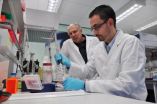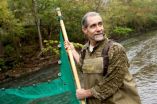(Press-News.org) Nanoparticles are becoming ubiquitous in food packaging, personal care products and are even being added to food directly. But the health and environmental effects of these tiny additives have remained largely unknown. A new study now suggests that nanomaterials in food and drinks could interfere with digestive cells and lead to the release of the potentially harmful substances to the environment. The report on dietary supplement drinks containing nanoparticles was published in the journal ACS Sustainable Chemistry & Engineering.
Robert Reed and colleagues note that food and drink manufacturers use nanoparticles in and on their products for many reasons. In packaging, they can provide strength, control how much air gets in and out, and keep unwanted microbes at bay. As additives to food and drinks, they can prevent caking, deliver nutrients and prevent bacterial growth. But as nanoparticles increase in use, so do concerns over their health and environmental effects. Consumers might absorb some of these materials through their skin, and inhale and ingest them. What doesn't get digested is passed in urine and feces to the sewage system. A handful of initial studies on nanomaterials suggest that they could be harmful, but Reed's team wanted to take a closer look.
They tested the effects of eight commercial drinks containing nano-size metal or metal-like particles on human intestinal cells in the lab. The drinks changed the normal organization and decreased the number of microvilli, finger-like projections on the cells that help digest food. In humans, if such an effect occurs as the drinks pass through the gastrointestinal tract, these materials could lead to poor digestion or diarrhea, they say. The researchers' analysis of sewage waste containing these particles suggests that much of the nanomaterials from these products are likely making their way back into surface water, where they could potentially cause health problems for aquatic life.
INFORMATION:
The authors acknowledge funding from the National Science Foundation.
The American Chemical Society is a nonprofit organization chartered by the U.S. Congress. With more than 161,000 members, ACS is the world's largest scientific society and a global leader in providing access to chemistry-related research through its multiple databases, peer-reviewed journals and scientific conferences. Its main offices are in Washington, D.C., and Columbus, Ohio.
To automatically receive news releases from the American Chemical Society, contact newsroom@acs.org.
Follow us: Twitter Facebook
Nanoparticles from dietary supplement drinks likely to reach environment, say scientists
2014-06-18
ELSE PRESS RELEASES FROM THIS DATE:
BU-lead study shows surprising spread of spring leaf-out times
2014-06-18
(Boston) – Despite conventional wisdom among gardeners, foresters and botanists that woody plants all "leaf out" at about the same time each spring, a new study organized by a Boston University biologist found a surprisingly wide span of as much as three months in leaf-out times. Significantly, observations the past two springs of 1,597 woody plants in eight botanical gardens in the U.S., Canada, Germany and China suggest that species differences in leaf-out times could impact the length of the growing season and the activities of birds, insect and other animals and therefore ...
Innovative technologies in rural areas improve agriculture, health care
2014-06-18
TAMPA, Fla. (June 18, 2014) – The current special issue of Technology and Innovation is devoted to articles on both innovations in rural regions and general articles on technology and innovation, including an article from the National Academy of Inventors (NAI) by McDevitt et al. that discusses the value of technology transfer for universities beyond money.
The five papers in this special issue of Technology and Innovation dealing with innovations in rural regions include an editorial, an analysis of the value of networks for European organic farmers and conventional ...
Self-repairing mechanism can help to preserve brain function in neurodegenerative diseases
2014-06-18
New research, led by scientists at the University of Southampton, has found that neurogenesis, the self-repairing mechanism of the adult brain, can help to preserve brain function in neurodegenerative diseases such as Alzheimer's, Prion or Parkinson's.
The progressive degeneration and death of the brain, occurring in many neurodegenerative diseases, is often seen as an unstoppable and irrevocable process. However, the brain has some self-repairing potential that accounts for the renewal of certain neuronal populations living in the dentate gyrus, a simple cortical region ...
When it comes to numbers, culture counts
2014-06-18
CAMBRIDGE, MA -- American children learn the meanings of number words gradually: First they understand "one," then they add "two, "three," and "four," in sequence. At that point, however, a dramatic shift in understanding takes place, and children grasp the meanings of not only "five" and "six," but all of the number words they know.
Scientists have also seen this pattern in children raised speaking other languages, including Japanese and Russian. In all of these industrialized nations, number learning begins around age 2, and children fully understand numbers and counting ...
3D breast imaging could revolutionize cancer screening
2014-06-18
Leesburg, VA, June 17, 2014—In community-based radiology practice, mammography screening with 3D digital breast tomosynthesis (DBT) yielded lower recall rates, an increased overall cancer detection rate, and an increased detection rate for invasive cancer compared with 2D digital mammography (DM).
In the largest report to date, researchers at Washington Radiology Associates, PC, with offices in Washington, DC; Virginia; and Maryland, conducted a study of more than 59,000 patients. The results were striking: an increase in the detection rate for cancer overall of 28.6% ...
Exposure to TV violence related to irregular attention and brain structure
2014-06-18
INDIANAPOLIS -- Young adult men who watched more violence on television showed indications of less mature brain development and poorer executive functioning, according to the results of an Indiana University School of Medicine study published online in the journal Brain and Cognition.
The researchers used psychological testing and MRI scans to measure mental abilities and volume of brain regions in 65 healthy males with normal IQ between the age of 18 and 29, specifically chosen because they were not frequent video game players.
Lead author Tom A. Hummer, Ph.D., assistant ...
Wildlife scientists map fishing resources to assist land managers, anglers
2014-06-18
Anglers in North Carolina and Virginia who are looking for privacy at good fishing spots should head for the mountains, according to a Virginia Tech study of the capacity, quality, and demand of freshwater recreational fishing sites in the two states.
"Our objective was to map a cultural ecosystem service by identifying the key features that influence anglers' enjoyment, such as environmental quality, accessibility, and fish abundance," said Amy Villamagna, a research scientist with the College of Natural Resources and Environment's fish and wildlife conservation department. ...
New method to identify inks could help preserve historical documents
2014-06-18
The inks on historical documents can hold many secrets. Its ingredients can help trace trade routes and help understand a work's historical significance. And knowing how the ink breaks down can help cultural heritage scientists preserve valuable treasures. In a study published in the Journal of the American Chemical Society, researchers report the development of a new, non-destructive method that can identify many types of inks on various papers and other surfaces.
Richard Van Duyne, Nilam Shah and colleagues explain that the challenge for analyzing inks on historical ...
Ban on pavement sealant lowered levels of potentially harmful compounds in lake
2014-06-18
In 2006, Austin, Texas, became the first city in the country to ban a commonly used pavement sealant over concerns that it was a major source of cancer-causing compounds in the environment. Eight years later, the city's action seems to have made a big dent in the targeted compounds' levels — researchers now report that the concentrations have dropped significantly. They published their study in the ACS journal Environmental Science & Technology.
Peter C. Van Metre and Barbara J. Mahler point out that in 2005, researchers figured out that pavement sealants made from coal ...
Majority of minors engage in sexting, unaware of harsh legal consequences
2014-06-18
Sexting among youth is more prevalent than previously thought, according to a new study from Drexel University that was based on a survey of undergraduate students at a large northeastern university. More than 50 percent of those surveyed reported that they had exchanged sexually explicit text messages, with or without photographic images, as minors.
The study also found that the majority of young people are not aware of the legal ramifications of underage sexting. In fact, most respondents were unaware that many jurisdictions consider sexting among minors – particularly ...



